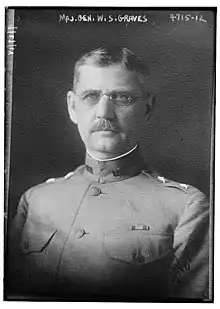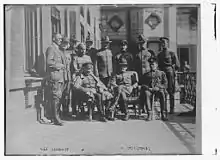William S. Graves
Major General William Sidney Graves (27 March 1865 – 27 February 1940), United States Army, commanded American forces in Siberia during the Siberian Expedition, part of the Allied Intervention in Russia.
William Sidney Graves | |
|---|---|
 Graves in 1918 | |
| Born | March 27, 1865 Mount Calm, Texas |
| Died | February 27, 1940 (aged 74) Shrewsbury, New Jersey |
| Place of Burial | |
| Allegiance | |
| Service/ | |
| Years of service | 1889–1928 |
| Rank | |
| Commands held | |
| Battles/wars | Spanish–American War Philippine–American War World War I Russian Civil War |
| Awards | Distinguished Service Medal Philippine Campaign Medal World War I Victory Medal Order of the Rising Sun (Japan) Order of Wen-Hu Order of the Crown of Italy Czechoslovak War Cross |
| Other work | Author |

Early life and education
He was born on 27 March 1865 in Mount Calm, Texas to the Reverend Andrew Carrol, a Southern Baptist minister and Evelyn Bennett.[1][2][3][4] Graves attended the United States Military Academy at West Point and graduated on 12 June 1889.[1][3]
Marriage
Graves married Katherine Pauline "Kate" Boyd, daughter of William Lang and Augusta Josephine (née Merriam) Boyd, at St. Mark's Episcopal Church in Cheyenne, Wyoming,[5] on 9 February 1891.[4] Katherine was the niece of his commanding officer, Henry C. Merriam.[4][6][7]
Military career
He served in the Spanish–American War in the Philippines until 1902.[8] He fought at the Battle of Caloocan as a company commander during the insurrection. He was the assistant chief of the Army General Staff.[9]
In 1918, he was given command of the 8th Infantry Division and sent to Siberia under direct orders from President Woodrow Wilson. He landed on September 1, 1918.[8] His orders were to remain strictly apolitical amidst a politically turbulent situation. As a result, he was frequently at odds with his Allied peers, the State Department, and various Russian groups.
Given some 7,000 soldiers in what was called the American Expeditionary Forces (A.E.F.), he settled on the idea of making sure the Trans-Siberian railroad stayed operational and brought in a number of railroad experts to run the railway. His troops did not intervene in the Russian Civil War despite strong pressure brought on him to help the White army of Admiral Kolchak. Early on, Graves developed a strong distaste for Kolchak and his government.[9]
Graves thought that the British, French, and Japanese forces in Siberia were all following self-serving political ambitions beyond the stated goals of the Allies, which were to protect supplies provided by the powers to their erstwhile Tsarist allies and to provide for the safe conduct of foreign allied troops, primarily Czechs, who were to exit Russia via Vladivostok. Graves believed that the British and French were trying to suppress Bolshevik forces. He also believed that the Japanese had plans to annex part of Eastern Siberia (the Amur region, east of Lake Baikal). The Japanese deployed an estimated 72,000 soldiers—some 6 times the authorized troop level of 12,000 set by the Allies.
U.S. forces operated the Trans-Siberian railroad for almost two years, while bandits roamed the Siberian countryside and the political situation turned chaotic. The U.S. military did accomplish its main objective and the entire Czech Legion was evacuated out of Russia via Vladivostok. The last U.S. soldiers left Siberia April 1, 1920. Historian Benson Bobrick wrote of Graves: "In the whole sad debacle, he may have been the only honorable man."[10]
General Graves was promoted to the rank of major general on 11 July 1925,[3] and retired from the army in 1928. He then wrote a book about his time in Siberia, entitled America's Siberian Adventure 1918-20.[11][8][12]
Family
William and Kate had four children, two of whom survived their parents. The first two children are buried at Fort Logan National Cemetery in Denver, Colorado: a newborn infant (died October 27, 1891) and a girl, Marjorie (19 November 1892 – 24 February 1894).[13]
A son, Sidney Carroll Graves (1893–1974) graduated from West Point in 1915 and followed his father into a military career, attaining the rank of major. He earned two Distinguished Service Crosses: the first during World War I, and the second while serving in the Russian Expeditionary Force. In 1921 he married Olga Roosevelt (Bayne), a relative of President Theodore Roosevelt. Olga's grandfather, Robert Barnwell Roosevelt, and the president's father, Theodore Roosevelt, Sr., were brothers.[2]
The youngest child, Dorothy, married William R. Orton.[2]
Death
Graves died on February 27, 1940 in Shrewsbury, New Jersey.[8]
Legacy
His papers are held in the Hoover Institution Archives at Stanford University.[15]
Footnotes
- "The Graves Family Newsletter". Volumes 17–21. 1994. p. 77.
- Davis, Henry Blaine (1998). Generals in Khaki. p. 152.
- "Gen. WS Graves, Siberian AEF Commander, Dies". Chicago Tribune. February 28, 1940.
- Pope, Charles Henry (1906). Merriam Genealogy in England and America. Boston, Massachusetts: Charles H. Pope. p. 374.
- Certificate of Marriage. Arapaho County, Colorado. County Clerk Jos H Smith. Filed: 12 February 1891.
- "Fort Logan History". Colorado Department of Human Services.
- Cullum, George; Washington, and United States Military Academy. Association of Graduates (1901). Biographical Register of the Officers and Graduates of the U.S. Military Academy at West Point, N.Y. (3rd ed.). Houghton, Mifflin. p. 487.
- Davis Jr., Henry Blaine (1998). Generals in Khaki. Pentland Press, Inc. pp. 152–153. ISBN 1571970886. OCLC 40298151.
- "Graves To Lead Our Siberian Army. Former Assistant Chief Of General Staff To Have 7,000 Men At The Start. Troops From Philippines 27th and 31st Regiments". New York Times. August 8, 1918.
- Benson Bobrick, East of the Sun: The Conquest and Settlement of Siberia (Heinemann, 1992: ISBN 0434928895), p. 398.
- General William S. Graves, America's Siberian Adventure (1918-1920)
- Graves, William Sidney. America's Siberian Adventure, 1918-1920. New York: J. Cape & H. Smith, 1931. OCLC 1134889
- "VA National Cemeteries: Gravesite Locator". U.S. Department of Veterans Affairs: National Cemetery Administration.
- "Valor awards for William Sidney Graves".
- House, John M. (2016). Wolfhounds and Polar Bears: The American Expeditionary Force in Siberia, 1918-1920. The University of Alabama Press. p. 224. ISBN 9780817318895.
References
- Kennan, George F.: The Decision to Intervene
- Biography of Graves on HHSWeb.com
- Obituaries of Graves from the New York Times and the Herald Tribune
- Maj. Gen. William S. Graves, U.S. Army – Truly a Soldier of the Old School by G. Russell Evans, Captain, U.S. Coast Guard (Ret.)
- Graves, William S. (1931). America's Siberian Adventure 1918-1920. New York: Peter Smith.
External links
| Wikiquote has quotations related to: William S. Graves |
- Works by William Sidney Graves at Faded Page (Canada)
- William S. Graves at Find a Grave
